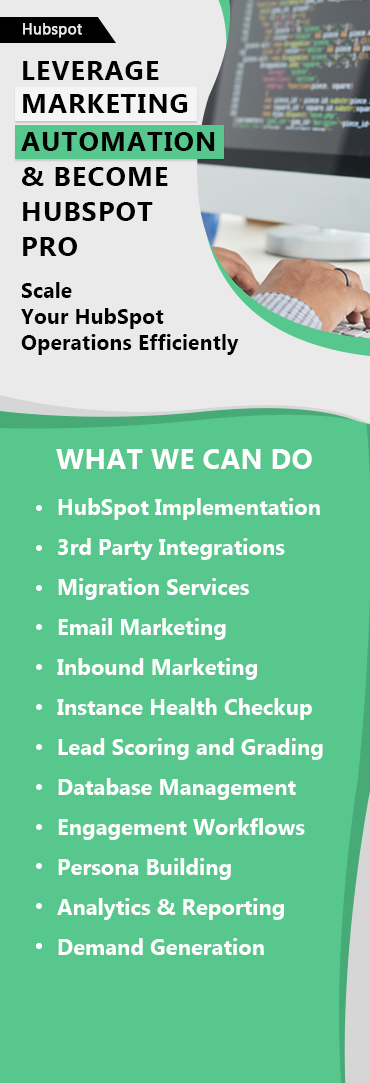If you’re a HubSpot user, we’re sure that you know the excitement that comes along whenever a new feature or capability is announced.
HubSpot users had been asking for ‘custom objects’ and HubSpot delivered! Their development team has unveiled ‘custom objects’ as a powerful addition for many businesses – especially larger businesses with complex data requirements. It is particularly useful for these businesses that are looking to flexibly and scalably organize their data.
This means that you can have a system completely customized to suit the needs of your growing team. And your customers will be using the same platform they are accustomed to, so the learning curve will be small.
Let’s explore all about it.
What are HubSpot Standard Objects?
Objects are the defined repository for the data that you’re keeping track of. In HubSpot, objects are pre-defined and built into the system and are known as ‘Standard Objects’. Until now, HubSpot had 4 groups of objects, namely:
- Contacts
- Companies
- Deals
- Tickets

These pre-defined objects ensure that your CRM is always keeping tabs on which Contact at which Company is involved in which ongoing Deals. Each object has distinctive properties that you can use to collect information about a particular record of that type.
However, they don’t cover everything you need when it comes to organizing and reporting your data in a way that aligns with how your business operates. And that is where custom objects come to the rescue.
What are HubSpot Custom Objects?
Custom objects enable you to define objects per your business requirements. It’s important to note that custom objects are available for the Enterprise accounts of any hub, so make sure that you have an Enterprise subscription.
HubSpot custom objects look and work exactly as standard objects do and can be used in reporting, marketing campaigns, and can be accessed easily by all users. They can be associated with other standard or custom objects, similar to your standard objects.
Why Use HubSpot Custom Objects?

Before HubSpot’s custom objects, data teams had to select a standard object to store data and manually update it from time to time. This made the process time-consuming and tiring to map, communicate with multiple teams, and introduce multiple APIs.
But with custom objects, you will get more insights with a more granular way to categorize and associate data. You can label data in your HubSpot database in a way that’s in sync with the reality of your business because of custom objects.
Once your custom objects are defined and records are set up, they function as the standard objects in HubSpot, enabling you to:
- Trigger workflows based on custom object values
- Create lists based on those values
- Personalize sales and marketing email campaigns
- Run reports recognizing trends among your database
Custom objects can also be imported like other objects and data can be filtered in the portal’s views.
Let’s take a look at this use case where your organization manages insurance for mid-sized companies and you work with both employers and insurance brokers.
In this case, you can use a custom property for ‘Brokers’ so that they’re not combined with the end-users/employers. This will help you to associate brokers with employer companies, contact records, and differentiate deals and tasks in a clear and defined way.
Here’s an example – one of our customers was struggling to manage ‘Broker’ data in HubSpot. We assisted them in capturing the accurate information of brokers in HubSpot and aligning them with Companies, Contacts, Tickets, Deals, and more. Thus, by implementing custom objects, the customer witnessed a 100% reduction in the broker commission grievances and a boost in the revenue generated by brokers by 120%.
We think this paints the picture of why custom objects are a must-have.
How to Create Custom Objects in HubSpot?
Now that you know a lot about custom objects, let’s look at the process of creating custom objects.
– Take time to plan out your needs. Check your standard objects and if they work, use them. But if they don’t align with your needs, you must identify the purpose, structure, required custom properties, and necessary associations for your new custom object.
– Next, these objects must be defined via an application programming interface (API). Therefore, you’d need to get a developer in the process.
– Once an object is created, you can start adding your data and creating records for that object.
– Make sure your custom objects are set up and the associations you made are accurate.
– Run a practice workflow to check that all associations and interactions between custom and standard objects are running smoothly.
With custom objects, you can definitely do more with HubSpot. So, if you’d need to gain control, segment better, and get a granular way to categorize and associate data in HubSpot, custom objects can be your best bet.
Wish to take your HubSpot operations up a notch with custom objects? Talk to us!












